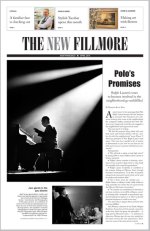
Classic Torso With Hands, 1952
Legendary photographer Ruth Bernhard, who lived up a narrow stair in a Victorian flat on Clay Street from 1953 until she died in December 2006 at age 101, was released to “fly with the angels” — her term for death — at a memorial service March 31 at Calvary Presbyterian Church.
Bernhard was remembered by scores of friends, former students and admirers as far more than one of the greatest photographers of all time.
She was a magical person, “like the Dalai Lama with a camera, spreading enlightenment,” said Los Angeles gallerist Peter Fetterman. He brought words of praise from director Steven Spielberg, who said he and his wife have Bernhard’s photographs in their bedroom, “so we sleep with her every night.”
Noted photographer Michael Kenna, one of Bernhard’s proteges, recalled working with her in the darkroom just off her kitchen, where they would sometimes stop to search for sustenance and drink plum wine and strong coffee. “Then, slightly intoxicated, jittery from caffiene, we’d go into the darkroom to make magic,” he said.
Joining her photographic family at the memorial was her brother, Alexander, who came from London. “Ruth was very, very happy to live in San Francisco and loved this place,” he said.
A friend remembered having sushi with her on Fillmore — “she favored Ten-Ichi” — and discussing other great photographers, including Berneice Abbott, who also lived long. “She’s too mean to die,” he recalled Bernhard saying.
No one felt that way about Ruth Bernhard. Many spoke to say she had opened their eyes and changed their lives.
“She may have lived long,” said another friend, “but she died young.”
Filed under: Art & Design | Leave a comment »





